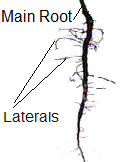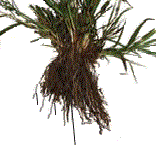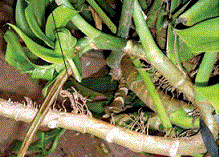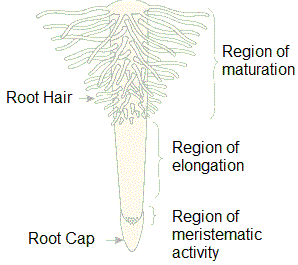Root system in flowering plant
The main functions of the root system are absorption of water and minerals from the soil, providing a proper anchorage to the plant parts, storing reserve food material and synthesis of plant growth regulators.
In majority of the dicotyledonous plants, the direct elongation of the radicle leads to the formation of primary root which grows inside the soil. The root is a brown, nongreen and underground part of a plant. Root with their branches is collectively called a root system. There are three types of the root system:
1. Taproot system
The taproot is mainly found in dicotyledonous plants. It develops from the radicle of the germinating seed, along with its primary roots and branches, giving rise to the taproot system. Mustard seeds, mangoes, grams and banyan are a few examples of dicotyledonous plants with taproot system.

2. Fibrous root system
In monocotyledonous plants, the primary root is short lived and is replaced by a large number of roots. These roots originate from the base of the stem and constitute the fibrous root system The fibrous root is mainly found in ferns and in all monocotyledonous plants. This root develops from thin, moderately branching roots or primary roots, growing from the stem. The fibrous root system usually does not penetrate deep into the soil, therefore, on full maturity, these roots look like a mat or a carpet on the floor. Wheat, paddy, grass, carrots, onion, grass are a few examples of monocotyledonous plants with the fibrous root system.

3. Adventitious root System
The roots which originate from any part of the plant body other than the radicle is called the adventitious root system. This root system is mainly found in all monocotyledonous plants. In plants, this root system is usefull for various purposes, like mechanical support, vegetative propagation, etc. Few examples of monocotyledonous plants with the adventitious root system are Banyan tree, maize, oak trees, horsetails.

Functions of Root
1. Storage.
2.Anchorage.
3.Absorption of water and minerals.
Regions of Root
The three regions of a root are as follows:
1. The root is covered at the apex by a thimble-like structure called the root cap
A few millimetres above the root cap is the region of meristematic activity.
2. The cells proximal to this region undergo rapid elongation and enlargement and are responsible for the growth of the root in length. This region is called the region of elongation.
3. The cells of the elongation zone gradually differentiate and mature. Hence, this zone, proximal to region of elongation, is called the region of maturation

Modifications of Tap Roots(For Food Storage)
In some of plants, the roots become fleshy due to the absorption of food material. The aerial parts of these plants are worn out due to unfavourable conditions. In favourable conditions they again new buds emerge either from the fleshy root or from a small bit of stem above. For example the carrot and turnip get swollen to store food.
On the basis of their shapes, they are classified:
| Class | Description | Example | Picture |
|---|---|---|---|
| Conical roots | These are broad at the base and conical at the apex | carrot |
|
| Fusiform roots | These are swollen in the middle and tapering towards both the ends | radish |
|
| Napiform roots | These are spherical at the base and taper towards the apex | turnip |
|
| Tuberous roots | They have no specific shape. They appear thick and fleshy | sweet potato |
|
Modification of Adventitious Roots(For Food Storage)
The roots are modified into following:
| Type | Description | Example |
|---|---|---|
| Simple Tuberous Roots | These are swollen and do not assume any shape. | Sweet potato |
| Nodulose Roots | These are single beads. They become swollen at the apex and have a definite shape | Ginger |
| Fasciculated Tuberous Roots | These are the cluster of adventitious roots for food storage. They have a definite shape | Dahlia |
| Moniliform Roots | These are swollen and constricted | Grasses |
| Annulated Roots | These have an appearance of discs placed one over the other | Ipecac. |
Modification of Adventitious Roots(For For Support)
The roots are modified into following:
| Type | Description | Example |
|---|---|---|
| Prop Roots | These roots develop from the branches of the tree, hang downwards, and penetrate into the ground thereby supporting the tree | Roots of the banyan tree. |
| Stilt Roots | These roots grow obliquely from the basal node of the stem. | Roots of the sugarcane. |
| Climbing Roots | These roots arise from the nodes and attach themselves to some support to climb over it. Thus, they provide support to the plant. | Money plant |
| Clinging Roots | These roots enter the crevices of some support and fix the plant. | Epiphytes orchids |
| Buttress Roots | These are vertically elongated basal part of the stem which spread in different directions in the soil. These are horizontally compressed and appear like planks. | Bombax. |
Modification of Roots(For special functions)
The roots are modified into following:
| Type | Description |
|---|---|
| Epiphytic Roots | These roots are aerial, hanging and spongy. They have a porous wall and absorb moisture from the atmosphere. These aerial roots possess a special sponge-like tissue known as velamen. Velamen absorbs and stores moisture from the air since these plants do not have direct contact with the soil. |
| Sucking Roots | These are microscopic, developed by the roots to absorb nutrients from the host. These are also known as parasitic roots or haustoria because these are found in non-green parasitic plants. These roots arise from the nodes and penetrate into the host tissue. They then enter into the conducting tissue from where they obtain the required food material. |
| Floating Roots | These arise from the nodes of the aquatic plants and help in floating and respiration. The example is Jussiaea. These roots are very spongy in nature and look like a mass of white cotton. The plant floats due to its buoyancy. They dry when taken out of the water. |
| Assimilatory Roots | These are also known as photosynthetic roots. These, when exposed to the sun, develop chlorophyll and manufacture food. For example in Tinospora, the roots hang as green threads from the nodes during the rainy season. They assimilate carbon dioxide in the presence of sunlight. |
| Mycorrhizal Roots | The symbiotic association of a fungus with higher plants is called mycorrhizal root. The fungus absorbs nutrients from the soil for the plant, and the plant, in turn, provides organic food to it. example is Pinus. |
| Reproductive Roots | In some plants such as sweet potato, the adventitious roots give rise to buds which develop into leafy shoots. Root cuttings are the main mode of reproduction. |




